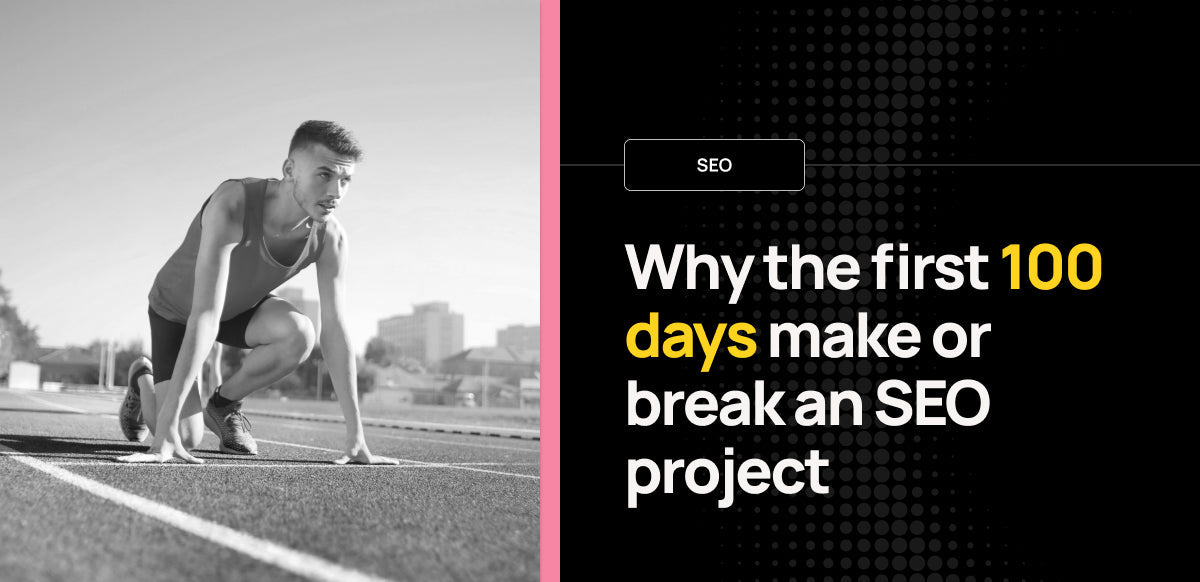Blog / Why the first 100 days make or break an SEO project
Why the first 100 days make or break an SEO project

Anyone who has worked agency-side knows the first hundred days decide whether a project builds momentum or stalls. Show movement in that window, and you set the tone for the next twelve months. Miss it, and even the best-looking roadmap struggles to recover trust.
The difficulty is that most structural SEO changes don’t show their full effect for around 60 days. Below is an example of one of our automated tests from Macaroni - here we added description copy to 108 collection pages and compared the results to pages of the same type that were unoptimised. As you can see, the full impact is visible around the 60-day mark.

Through Macaroni we have a large amount of data that backs this up across different types of optimisation. But on Shopify, where these changes - taxonomy, subcategories and internal linking - require significant work, that lag makes the challenge sharper. In reality, you don’t have a hundred days to prove impact; you have forty.
That’s why our first month is never just research and presentations. We implement. We map categories, clean up product data, and lay the groundwork for scale. We timestamp every change and track leading indicators like crawl, coverage and indexation, so progress is visible even before lagging metrics shift.
Here’s how we approach those first 100 days.
Day 0–10 – alignment and setup
∙ Access and modelling. Get Shopify, GA4 and GSC integrated into our systems so we can model performance by page type from the start.
∙ Ways of working. Establish a clear rhythm: weekly updates, monthly reporting, and quarterly reviews to keep priorities aligned.
∙ Diagnostics. Run early checks on tracking and site health to understand where data is reliable and where fixes are needed.
Days 1–30 – laying the foundations
∙ Taxonomy and mapping. Audit the current structure, highlight gaps, and define parent/child relationships that reflect how customers actually shop.
∙ Quick wins. Make visible improvements where the uplift is clearest - metadata, titles, descriptions, internal linking.
∙ Implementation first. Ensure changes are going live within the first month so the 60-day lag is already counting down.
Days 31–60 – implementation at pace
∙ From plan to site. Translate the mapping into live changes: new collections where gaps exist, refinements to navigation, breadcrumb updates.
∙ Content expansion. Widen optimisation beyond the initial priority groups, adding copy where it supports both search visibility and conversion.
∙ Technical hygiene. Address blockers surfaced in early audits, feeding fixes directly into development rather than leaving them parked.
Days 61–100 – scale and momentum
∙ Broader rollout. Extend taxonomy improvements across more of the catalogue, at a pace matched to resources and priorities.
∙ Content maturity. Introduce above-the-fold copy and richer assets on key pages, creating a template for wider rollout.
∙ Review and reset. Use the first quarterly review to assess what has shipped, what signals we’re seeing, and agree the next wave of execution.
Why this approach works
∙ Early implementation reduces risk. By shipping in the first month, the 60-day lag is already running.
∙ Flexible, not formulaic. The mix of deliverables flexes to fit catalogue size and commercial goals. The principle that never changes is early momentum.
∙ Permanent improvements. Changes are made directly in Shopify - no overlays or temporary fixes – so the upgrades stay in place.
∙ Built-in communication. Weekly, monthly and quarterly check-ins keep progress visible and prevent surprises.
The principle behind it
Ship quickly, document every change, and focus on leading indicators. Do that, and the unavoidable lag becomes less of a risk - while your chances of long-term success rise sharply.






